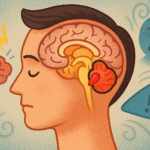Do we really see reality as it is? Spoiler: no. What you believe you see is not always what is actually there. Your brain doesn’t just record information from your senses — it interprets it, organizes it, and often… it deceives you.
One of the clearest examples of this is through optical illusions. Think of the famous drawing: do you see a young woman or an old lady? The same image can create two completely different perceptions depending on how your brain interprets the lines. This shows that what reaches our eyes is only the beginning — the rest is shaped by memory, emotions, culture, and expectations.
Sensation vs. Perception: What’s the Difference?
In psychology, sensation refers to the raw data received by your senses — light, sound, touch, smell, taste. Perception, on the other hand, is the process by which your brain interprets that data and turns it into meaningful information. In other words, sensation is what you receive, perception is how you understand it.
For example: your eyes receive waves of light, but your brain tells you whether you’re seeing a face, a word, or an illusion.
Why Do We Perceive Differently?
Your perception is never neutral. Several factors influence how you interpret reality:
- Memory: past experiences shape what you expect to see.
- Emotions: your mood can alter your perception — sadness, fear, or joy affect interpretation.
- Expectations: if you’ve been told to expect danger, you’ll perceive ambiguous situations as threatening.
- Culture: even the society you grew up in influences what you notice and how you interpret it.
That’s why two people can look at the same image, event, or conversation and perceive completely different realities.
Gestalt Psychology and Bruner’s Theory
The psychology of perception has been studied deeply. Gestalt psychologists like Max Wertheimer, Wolfgang Köhler, and Kurt Koffka showed that our brains tend to organize information into complete forms rather than isolated parts. We don’t just see lines and shapes — we see patterns, faces, and objects.
Later, Jerome Bruner highlighted that our perception is influenced by expectations and beliefs. In other words: we don’t see reality as it is, we see it as we are.
A Mirror of the Mind
Optical illusions reveal that perception is not a perfect mirror of the world, but a construction of the brain. They remind us that our experience of reality is always filtered, personal, and sometimes misleading.
And here’s the key: if our senses can be tricked so easily, what other aspects of our daily life might be influenced by these hidden filters?
Watch the Video on Our Channel
If you want to see these illusions in action and learn more about how your brain tricks you, check out our video on the PsyLife channel. There we explore the difference between sensation and perception in a simple, visual way, with examples that will make you question what you think you see.




